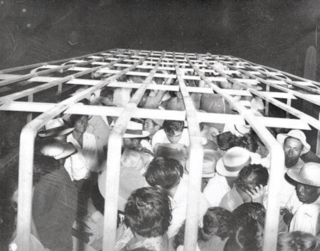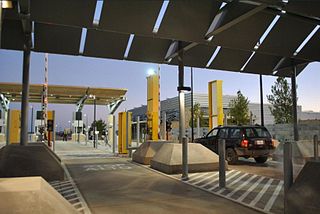
Wetback is a derogatory term used in the United States to refer to foreign nationals residing in the U.S., most commonly Mexicans. The word mostly targets illegal immigrants in the United States. Generally used as an ethnic slur, the term was originally coined and applied only to Mexicans who entered the U.S. state of Texas from Mexico by crossing the Rio Grande, which is the U.S. border, presumably by swimming or wading across the river and getting wet in the process.

The United States border with Mexico is one of the world's "most lethal land borders". Hundreds of migrants die per year as they attempt to cross into the United States from Mexico illegally. The US Border Patrol reported 251 migrant deaths in the fiscal year 2015, which was lower than any year during the period 2000–2014, and reported 247 migrant deaths in fiscal year 2020, lower than any year since 1998. Poverty, gang violence, poor governance, etc. are the main factors as to why migrants cross the US border. US Border Patrol recorded 557 southwest border deaths during fiscal year 2021 and 748 in the first 11 months of fiscal year 2022, the most deaths ever recorded.

The Ceuta border fence forms part of the Morocco–Spain border at Ceuta, a city on the North African coast. Constructed by Spain, its purpose is to prevent smuggling and to stop migrants from entering Europe. Morocco objected to the construction of the barrier since it does not recognize Spanish sovereignty in Ceuta.

The Mexico–United States border is an international border separating Mexico and the United States, extending from the Pacific Ocean in the west to the Gulf of Mexico in the east. The border traverses a variety of terrains, ranging from urban areas to deserts. The Mexico–U.S. border is the most frequently crossed border in the world with approximately 350 million documented crossings annually. It is the tenth-longest border between two countries in the world.

Foreign nationals (aliens) can violate US immigration laws by entering the United States unlawfully or lawfully entering but then remaining after the expiration of their visas, parole, or temporary protected status. Illegal immigration has been a matter of intense debate in the United States since the 1980s.
Mojados: Through the Night is a 2004 documentary film directed by Tommy Davis. The film documents the journey of four men as they trek 120 miles across the Texas desert.
Adolfo Dávila García is a Mexican video and film director who has primarily directed short films and documentaries.

American Mexicans are Mexicans of full or partial American heritage, who are either born in, or descended from migrants from the United States and its territories.

The Paso del Norte International Bridge is an international bridge which crosses the Rio Grande connecting the United States-Mexico border cities of El Paso, Texas, and Ciudad Juárez, Chihuahua. The bridge is also known as "Paso del Norte Bridge", "Santa Fe Street Bridge", "Puente Benito Juárez", "Puente Paso del Norte" and "Puente Juárez-Santa Fe". The Paso del Norte International Bridge is a four-lane bridge for northbound non-commercial traffic only. The bridge was constructed in 1967. The American side of the bridge is owned and operated by the City of El Paso.

Hotel de Inmigrantes is a complex of buildings, often compared to a citadel, constructed between 1905 and 1911 in Buenos Aires, Argentina to receive immigrants and stem the tide of communicable diseases following mass cholera outbreaks across the globe. The hotel, which saw more than a million immigrants pass through during its 42 years, now houses the National Museum of Immigration as well as the National University of Tres de Febrero's Contemporary Art Center.

Colloquially, a coyote is a person who smuggles immigrants across the Mexico–United States border. The word "coyote" is a loanword from Mexican Spanish that usually refers to a species of North American wild dog (Canis latrans).
The 2010 San Fernando massacre, also known as the first massacre of San Fernando, was the mass murder of 72 undocumented immigrants by the Los Zetas drug cartel in the village of El Huizachal in the municipality of San Fernando, Tamaulipas, Mexico. The 72 killed—58 men and 14 women—were mainly from Central and South America, and they were shot in the back of the head and then piled up together. The bodies were found inside a ranch on 24 August 2010 by the Mexican military after they engaged in an armed confrontation with members of a drug cartel. They received information of the place after one of the three survivors survived a shot to the neck and face, faked his death, and then fled to a military checkpoint to seek help. Investigators later mentioned that the massacre was a result of the immigrants' refusal to work for Los Zetas, or to provide money for their release.
Illegal immigration in Mexico has occurred at various times throughout history, especially in the 1830s and since the 1970s. Although the number of deportations is declining with 61,034 registered cases in 2011, the Mexican government documented over 200,000 illegal border crossings in 2004 and 2005. The largest source of illegal immigrants in Mexico are the impoverished Central American countries of Guatemala, Haiti, Honduras, and El Salvador and African countries like Democratic Republic of Congo, Cameroon, Guinea, Ghana and Nigeria. The largest single group of immigrants in Mexico is from the United States, at 1.5 million, many of whom overstay their visas. Americans are the largest group of immigrants in Mexico. They number 1.5 million, many of them being without legal status since they overstayed their visas.

La Bestia, also known as El Tren de la Muerte and El Tren de los Desconocidos, refers to a freight train that starts its route in Chiapas state in southern Mexico, near the border of Guatemala. From there it travels north to the Lecherías station on the outskirts of Mexico City, where it connects with a network of Mexican freight trains heading to different points on the U.S. border. It is estimated that each year, between 400,000 and 500,000 migrants, the majority of whom are from El Salvador, Guatemala, and Honduras, ride atop these trains in the effort to reach the United States. Although these trains are regarded as a free form of travel that allows migrants to avoid Mexico's numerous immigration checkpoints and 48 detention centers, the risks are high and many riders are left with life-altering injuries that limit their capacity to work.

The Marcelino Serna Port of Entry is a crossing of the United States–Mexico border. It opened on November 17, 2014, replacing the nearby Fabens Port of Entry. The crossing is built around the Tornillo–Guadalupe International Bridge about 1,800 feet (550 m) west of the previous two-lane Fabens–Caseta International Bridge and can accommodate vehicular, pedestrian, and commercial traffic. The U.S. Customs and Border Protection (CBP) facility at the crossing served as the site for the Tornillo tent city, which housed as many as 2,800 detained migrant youths from June 2018 to January 2019. As of July 2019, a 2,500-bed holding facility for adult migrants is under construction at the site.

The 2014 American immigration crisis was a surge in unaccompanied children and women from the Northern Triangle of Central America (NTCA) seeking entrance to the United States in 2014. According to U.S. law, an unaccompanied alien child refers to a person under 18 years of age, who has no lawful immigration status in the U.S., and who does not have a legal guardian to provide physical custody and care.

Britons in Mexico, or British Mexicans, are Mexicans of British descent or British-born persons who have become naturalized citizens of Mexico.
Borderland is a limited-run 2014 television documentary series, produced by Australian production company In Films. It was the first original commission for Al Jazeera America's documentary unit, premiering on 13 April 2014. The series followed six Americans as they retraced the fatal journey of three undocumented migrants who died attempting to cross into the United States.
Missing in Brooks County is a 2020 feature-length documentary, directed and filmed by Lisa Molomot and Jeff Bemiss. Its subject is the passage of illegal migrants through Brooks County, Texas, and specifically how thousands die of dehydration and exposure hiking some 35 miles (56 km) across open fields in 100 °F (38 °C) heat, to avoid the Border Patrol internal checkpoint near Falfurrias, Texas. The ground is sandy and taxing to walk in, and lack of landmarks makes it easy for migrants to get lost and go in circles. Brooks County leads the nation in migrant deaths; most bodies are never found, and most of those found are never identified. The county sheriff calls the county "the biggest cemetery in the United States". News stories have called it "migrants' Death Valley."













